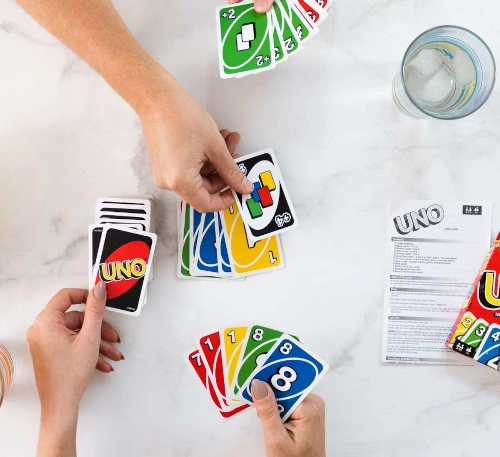UNO is a game that brings people together for fun, laughter, and competition. But have you ever tried House Rules for UNO? House rules are a way to customize the game to suit your group’s style. Whether you want more challenges or just some hilarious twists, house rules add a personal touch to every game session. Let’s explore everything you need to know about house rules for UNO in a simple and fun way.

What Are House Rules in UNO?
House rules refer to custom rules that players agree to follow during the game. These rules are not part of the official UNO instructions but are added to make the game more interesting, competitive, or silly. Playing House Rules is a way to make the game match your group’s personality and style.
Why Use House Rules for UNO?
Using house rules in UNO is a fun way to change up the game experience. Here’s why you should try it:
- More Fun and Creativity: House rules bring unique twists and surprises.
- Competitive Edge: Adds strategy and planning opportunities.
- Group Customization: It’s a way to make the game fit your group’s vibe and mood.
- Breaking the Routine: Instead of sticking to standard rules, house rules can keep the game fresh and exciting.
Popular House Rules for UNO
Here are some popular and fun house rules that can make your UNO sessions more interesting:
1. Stacking Rule
The Stacking Rule makes playing Draw cards more intense. This means that when a player puts down a Draw Two or Wild Draw Four card, the next player can add another Draw Two or Wild Draw Four card instead of drawing the cards.
For example: If Player 1 plays a Draw Two card, Player 2 can also play a Draw Two card instead of drawing. This continues until a player can’t stack anymore.
2. 7-0 Rule
The 7-0 Rule creates unexpected twists during gameplay. If a player plays a 7 card, they can swap hands with any other player. If someone plays a 0 card, all players pass their hands to the next person in the circle. This rule keeps everyone guessing and makes it harder to predict the winner, adding excitement and surprises to the game.
3. Jump-In Rule
The jump-in rule allows players to interrupt the game if they have an exact match. For instance, if someone plays a yellow 5, another player with the same yellow 5 can jump in. This rule adds fast-paced excitement.
4. Draw Until You Match Rule
This rule adds a suspenseful twist to drawing cards. If a player doesn’t have a card that matches the top of the discard pile, they must keep drawing until they find a matching card by color or number. This can lead to players drawing many cards, which creates unpredictable moments and laughter as hands grow bigger.
5. Reverse Swap Rule
In the Reverse Swap Rule, if a Reverse card is played:
- The player must swap their hand with another person in the game.
- This can change everything about the game’s direction and strategy
6. No Action Card Penalty
If you play a number card instead of an action card, you get a penalty:
- You must draw an extra card from the draw pile.
- This adds pressure to every turn and forces players to think strategically.
7. Custom Wild Card Rules
With this rule, Wild cards get special powers decided before the game begins. For example, a Wild card might let you skip two players, reverse the direction, or make the next player draw cards. This rule allows you to be creative and add a personal touch to your Uno games.
8. Skip Everyone
The Skip Everyone Rule is a fun way to take the Skip card to the next level. When a player uses a Skip card, it doesn’t just skip the next player—it skips all the players in the game and brings the turn back to the person who played the card. This rule adds a powerful advantage to the Skip card, allowing the player to take consecutive turns and possibly finish their cards quickly.
Things to Do Before Playing with House Rules
Before diving into an Uno game with house rules, it’s important to set the stage for a fun and enjoyable experience. Here are some simple steps to follow:
- Discuss Before Starting: Make sure everyone agrees on the house rules before the game begins. Clear communication avoids confusion later.
- Start Small: Begin with one or two house rules to see how they work with your group.
- Keep It Fun: The purpose of house rules is to make the game more exciting, not overly complicated.
- Be Flexible: If a rule isn’t working well, adjust it or try something different to keep the game enjoyable for everyone.
Tips for Using House Rules
Using house rules can make UNO more exciting, but it’s important to keep the game fun and manageable for everyone. Here are some tips to get the most out of your customized rules:
- Keep the rules simple to avoid confusion.
- Try one or two house rules at a time to see how they affect gameplay.
- Adjust the rules based on your group’s preferences.
Conclusion
House rules in UNO are a fantastic way to add creativity, strategy, and surprise to your game sessions. Whether you’re playing with the 7-0 swap, stacking, or no action card penalties, these rules personalize the game to match your group’s mood and energy. Don’t hesitate to experiment with different house rules. Remember, the aim is to enjoy and make your game sessions more thrilling and fun. So grab your UNO deck and gather your friends – it’s time to create some unforgettable house rule moments!
FAQ
Can House Rules Be Combined?
Yes! You can combine different house rules to create a customized game experience that suits your group’s style.
Are House Rules Common in UNO Competitions?
No. House rules are generally not used in official UNO tournaments. In competitions, players follow the standard UNO instructions.
What is the Most Popular House Rule in UNO?
The Stacking Rule and the 7-0 Swap Rule are two of the most popular and exciting house rules.
How Can I Explain House Rules to New Players?
Be clear and concise. Simply state what each house rule means before the game starts, and demonstrate with a quick example.
Can You Change House Rules During the Game?
Yes, you can modify house rules during the game if everyone agrees. However, it’s better to decide the rules before starting to avoid confusion.

